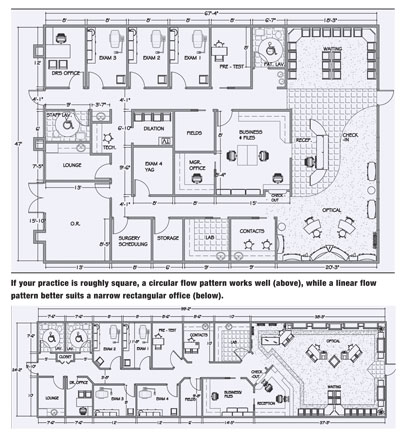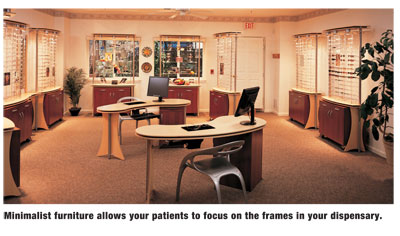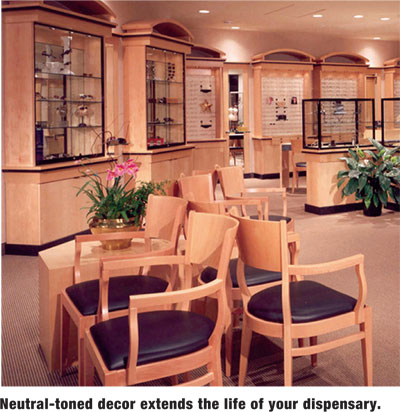Has your appointment schedule become lean? Do your patients and staff collide in the halls? Are your high-end dispensary products collecting dust? Have you been losing patients to competitors even though you are a knowledgeable and experienced practitioner? Have patients told you that your office reminds them of an exhibit at the Smithsonian? If you answered yes to any of these questions, it may be time to update your office design.
The ophthalmic industry is a high-tech, high-fashion industry, says Alan Winig, president of Eye Designs, LLC, based in
Indeed, with technological advancements changing patient care, and office design that streamlines and enhances your presentation, there is no time like the present to update your practice.
Here are five steps you can take to retain your current patients, attract new ones, and perhaps lure back those who have left.
1. Go with the Flow
A key factor in office productivity is efficient patient flow, says Dan Sloan, a designer for 18 years with Fashion Optical Displays, in
You must literally walk the path of your patients, Mr. Sloan says. Do patients double back to get from the exam room to the dispensary? Do they walk through the entire office to get from the waiting area to the pre-test room? he asks. If your layout doesnt allow for easy transitioning, it lowers your efficiency levels by creating bottlenecks between stations.
Now, examine your office to determine the most efficient way your patients could move through it. Is your office space roughly square? If this is the case, consider a central entry point paired with a circular flow pattern, he says. It prevents overcrowding in hallways and its easier to move patients from one room to the next, Mr. Sloan says. After the exam, the patient can exit without having to backtrack through the rest of the office.
If your office is rectangular and narrow, consider linear design, with patients moving up one side of the hallway and down the other, Mr. Winig says, and adds that this works best with a hallway of at least four feet in width.
An L-shaped practice, however, is more difficult to work with efficiently. Space permitting, Mr. Winig recommends making one wing into non-patient spacesuch as offices, a staff lounge, or storage roomsso that your patient flow can be limited to a more manageable area.

Your patients will be impressed and reassured if your practice demonstrates technological aptitude, says Michael Sopher, vice president of sales and training for EYEmaginations, Inc., of Towson, Md. When patients walk into a practice and theres technology that speaks directly to them, they see that the doctor is investing in cutting-edge eye care for their benefit.
Consider key pieces of technology that create a wow factor for your patients, such as interactive patient education features or integration-ready practice management software. Doctors need to consider: Will this technology differentiate me from my competition? he says, A combination of different technologies makes patients say, Wow, this is really impressive. That wow factor is so critical.
Why? A visible investment in technology assures your patients that the eye care you provide is informed by the latest technological advances, says Ed Buffington, president and chief operating officer of OfficeMate, of Irvine, Calif. Keeping pace with technology says to your patients, Ive got the best technology, and I give the highest quality eye exams, he says. The right technology can allow you to remain fully engaged with your patients while youre providing care for them. (See The Technological Wow Factor, below.)
When you look to upgrade your technology, consider the source. You have to ask the vendors, Who are you interfaced with? What references can you provide? Mr. Buffington says. Understanding the possibilities of interfacing software with equipment helps you select technologies that best fit your practice, and carefully selecting your provider ensures the quality of the technology you invest in.
If you are not ready to integrate, however, then now may not be the best time for you to invest in new technology. Does the doctor perceive a need for this technology? If not, then this might not be the right time to move forward with it, says Mr. Sopher. When doctors make the decision prematurely, the chosen system typically sits on the shelf.
Designers will fit their display systems to your specifications, so make sure to consider the technology you have and the technology you plan to integrate when you redesign your office.
The Technological Wow Factor So, youre considering adding some new technological features to your practice. Where do you start?
Patient education features are one way to make an impact from the get-go; as soon as patients walk into your reception area, relevant information is presented concisely and in a manner that appeals to each viewer. For example:
The WinkPad, by Wink Interactive, Inc., derives content from www.AllAboutVision.com and presents this doctor-reviewed information to your patients in a reader-friendly format. The hand-held WinkPad is intended for use in the reception area. (Wink Interactives strategic partner is Jobson Publishing, the publisher of Review of Optometry.) Go to www.winkinteractive.org.
The 3-D Eye Office, by EYEmaginations, Inc., is an animated patient-education platform that allows you to loop chosen sequences of video in your reception area or to select certain animations for use in the exam room. Go to www.eyemaginations.com.
Or, if youre looking at new exam software or practice management systems, consider going paperless or reducing your paper usage through integration. In terms of medical records, the office can absolutely become paperless, says Ed Buffington, CEO of OfficeMate, Inc. For example:
The OfficeMate SuiteOfficeMate, ExamWRITER, and ReportWRITERby OfficeMate, consists of practice management software, report software, and electronic health record software. OfficeMate has also partnered with Motion Computing to offer the Motion Tablet PC, and interfaces with several brands of exam equipment, as well as EYEmaginations software. Go to www.officemate.net.
Practice Director, by Williams Group, consolidates office records into one program, at the core of which is an electronic medical records keeper. Written on a JAVA platform by Sun Microsystems, Practice Director operates on Windows, Mac, or Linux, and updates via a secure Internet connection. Go to www.practicedirector.com.
3. Minimize Distraction
A minimalist design scheme minimizes the chance that patients will be distracted. Your design scheme should convey how you want to be seen by your patients: clean, inviting, and professional, Mr. Sloan says. However, you do not want it to overpower the frames in your dispensary or disguise the fact that your office is, first and foremost, a medical facility. The worst thing that could happen is the patient would walk into the office and want to buy your beautiful fixtures or cabinetry, and they completely overlook the frames in those fixtures, he says.
Mr. Sloans recommendation: a minimalist design scheme attracts patients but does not overwhelm your dispensaryor your patients. Tailor your practice to your patients, he says. What is best for your patients will be best for your practice. Step back and look at your design from their viewpoint, not yours.
By no means should your design scheme be boring, Mr. Winig says, but you must value function over form, including accommodations for your patients, such as a lower section of the reception counter for patients in wheelchairs.
If youre satisfied with your current layout and furnishings but still want to freshen up a little, consider redoing just your carpets and walls and rearranging the reception area, Mr. Sloan says. This is an excellent short-term, budget-savvy solution, he says, but it will not replace a full renovation.

Consider neutral tones, says Mr. Winig. Neutrals and wood finishes add a sense of classic professionalism. They keep the dispensary from looking commercial, he says. Real, natural finishes almost never go out of stylethey extend the life of the displays and furniture.
Likewise, consider furnishings with more than one color, or a subtle pattern, Mr. Sloan suggests. Furniture and fixtures have a life-span of about 10 years, so you want to look at long-lasting styles and tones, he says. Incorporating multiple colors in your fixtures allows you a choice of accent colors to use for your walls and carpetsand the flexibility to change them a few years down the line.

5. Light Up Your Life
You dont want a place thats dark and dingyits a medical facility. Keep it clean, open and inviting, and professional, Mr. Sloan says. Remember, in your dispensary, youre presenting a product that will be seen on the faces of your patients. Fluorescent lighting is the most energy-efficient, but the least flattering to your patientsand they will attribute their poor appearance to your frames, not your lights. So, use color-corrected bulbs or paracube diffusers to flatter your patients while being energy-conscious, Mr. Sloan says.
But, the frames you display in your dispensary benefit from extra spotlighting. So, to allow your frames and lenses to make the best impression possible, consider highlighting your fixtures with recessed incandescent lighting or halogen bulbs, Mr. Sloan says.
The most important factor to consider in redesigning is always your patients. When they respond to your technology, notice your furnishings, or follow the smooth layout of your office, the quality of your office indicates the high-quality care you provide. Your patients will feel like they are part of the experience, Mr. Sopher says. They walk out of your office feeling as though this was unique, this was good.

